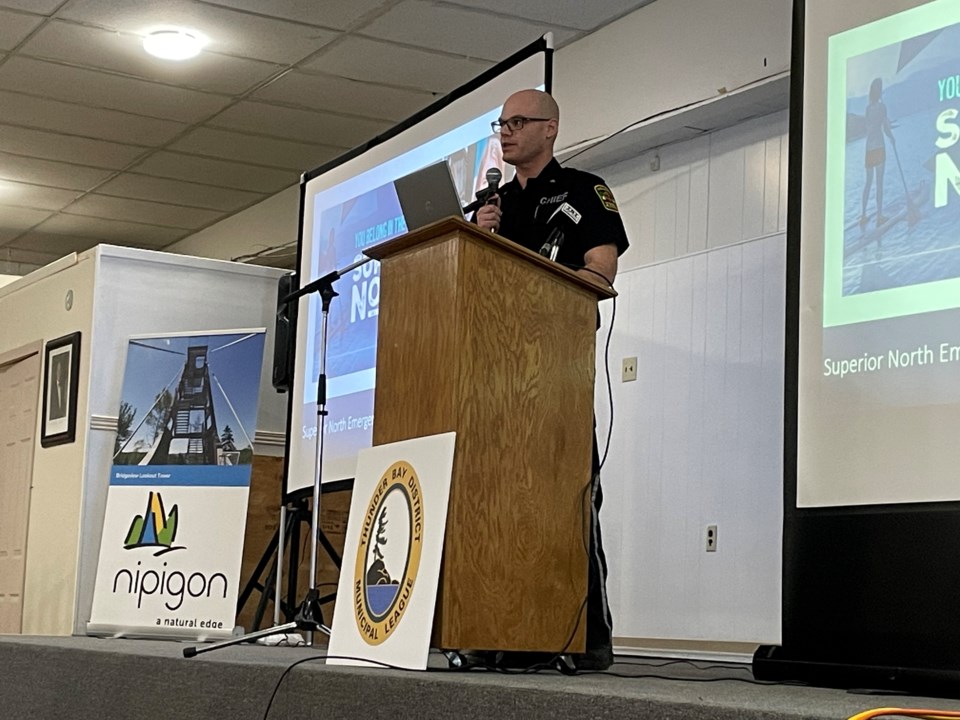NIPIGON — Considering a change of pace and looking to get into a growing profession?
Superior North EMS (SNEMS) Chief Shane Muir gave a presentation to municipal delegates at this year’s Thunder Bay District Municipal League conference and annual general meeting, where he offered some positive updates about the state of emergency medical care across the Superior North region and also addressed concerns about an ongoing paramedic shortage.
The conference was held Feb. 29 to March 1 at Branch 32 Legion in Nipigon.
It was mostly good news as Muir described the planned expansion of Superior North EMS programs, the introduction of new supports and resources available to EMS workers, and a slight decrease in call volumes in 2023.
“We're working on the community paramedic side, being really innovative, expanding health care from the EMS perspective, keeping seniors and people who need health care in their homes healthier, longer – avoiding some of those long-term care and hospital admissions,” he said.
He pointed specifically to the newly implemented medical priority dispatch system (MPDS) as one major reason SNEMS has seen a decrease in the number of calls and improved response times.
Already established in Central Ambulance Communications Centres throughout Toronto and Niagara, the MPDS is designed to help emergency medical dispatchers triage calls and better allocate resources so that the most urgent calls are prioritized to 9-1-1.
The MPDS uses a colour-coded system to designate the level of urgency for each call.
“We've created a whole new dispatch system that's really working well to try and get paramedics their meal breaks, getting home on time and really providing that quality of life at work and looking after our paramedics better,” Muir said.
But another big change when it comes to looking after their paramedics better, according to Muir, is the fact that SNEMS is now providing an “abundance of mental health programming” – including 24/7 access to mental health-care with a team of clinical psychologists from NWO Psychology on standby, dedicated appointment times in as little as 38 minutes, an increase in mental health benefits coverage, and access to the City of Thunder Bay Telus Health Employee and Family Assistance program.
“This is very new to the EMS. As a first responder agency, we know that we need to look after the mental health of our paramedics,” he said.
Muir also spoke about how community paramedicine programs are continuing to fill in health-care gaps in municipalities across the North Shore.
“We're seeing really positive data and results coming out of our community paramedic program, which is really exciting to see and it's stuff we want to expand on. They've created innovative new programs where they're doing lab values and point of care testing and really expanding on their scopes of practice,” he said.
The point-of-care testing that Muir mentioned includes equipment that can test for COVID, influenza, streptococcal, RSV, and other possible infections – or simply to check fluid levels.
SNEMS also created a virtual care coordinator position to better monitor patient conditions at home, increase the capacity of the community paramedicine program, and to test new technology that can “identify frailty by walking speed, gait, and falls detection.”
This all falls in line with Muir’s report that Ontario Health included community paramedicine as a priority area for 2023-24 – and it sounds like the plan is to keep building on what SNEMS has established so far in the region.
Community paramedicine programs are “100 per cent” funded by the province, Muir said.
Despite growth on the community paramedicine side of things, Muir also made it clear that the need for paramedics is a growing concern.
“We are currently in a staffing crisis. We desperately need paramedic recruitment,” he said.
With that in mind, SNEMS has ramped up a new digital media strategy to draw attention to the need and raise awareness about paramedicine and EMS as a viable career for those going into or returning to post-secondary studies – or even those simply looking for a career change.
“SNEMS is putting out its branding, putting out its culture, and really trying to attract people from the northern communities to work as paramedics.
“And this is something we want to work collaboratively with the college on to expand the number of seats in the Confederation College paramedic program. We’ll provide the preceptorship and create some collaborations there to really increase our student numbers and have more paramedics at the end of the day,” Muir said.
